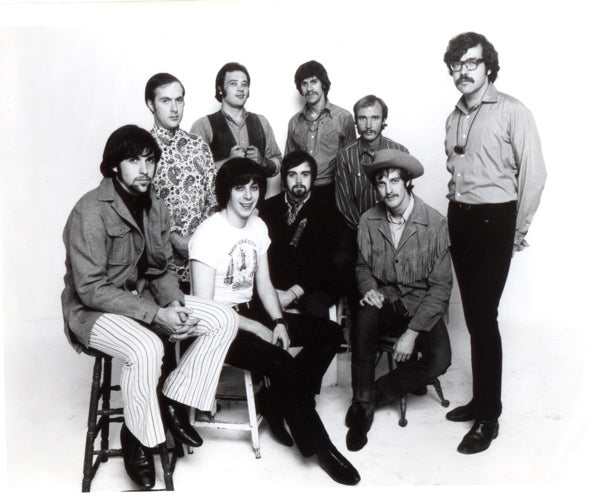The story of Blood Sweat & Tears is one that features huge commercial success, undermined by crippling personal divisions and internal squabbling that would ultimately cost the band dear. From almost their very beginning, they were subject to a series of forces and circumstances that eventually conspired to fatally undermine them.
The roots of BS&T lie in the disbanding of East Coast band The Blues Project, who had achieved some success on the US East Coast, but struggled to break out of the straitjacket of being ‘A Cult Band’. They included in their ranks the singer/ songwriter/ musician Al Kooper (who had achieved instant notoriety by dint of his organ playing on the Bob Dylan classic, ‘Like A Rolling Stone’, in 1965), and guitarist Steve Katz.
The story goes that Katz, together with a Jazz-influenced drummer, Bobby Colomby were listening to the album Time and Changes, by The Buckinghams, which featured layered horn and orchestral arrangements by producer James William Guercio. At the same time, Al Kooper was also mulling over a new band concept that could harness elements of James Brown, Tim Buckley, The Beatles, the Maynard Ferguson big band of the early to mid-sixties, and the searing soulfulness of The Four Tops, Percy Sledge, and Ray Charles – an ambitious project, to be sure, but in those free-wheeling, adventurous days – why not?
Kooper, Katz and Colomby put together an impromptu combo for some shows at New York’s Café Au Go Go, which went well, so much so that the three decided to throw in their lot together and move things on. By the time BST debuted onstage opening for Moby Grape at the Café Au Go Go, there were three major record companies vying to sign them. It was Columbia which ended up securing the band’s services, and in November 1967, BST started recording demo material, and a mere month later, commenced recording their first album, with John Simon producing.
The debut album would be released in February 1968, entitled The Child Is Father To The Man, and was a remarkable first foray, featuring Al Kooper in spellbinding form as composer and creator. Although the album attracted some positive press, it didn’t set the charts alight, peaking at number forty-seven on the US Billboard Album charts. The somewhat middling success emboldened Katz and Colomby to make a move to wrest creative control away from Kooper, who accepted an A&R position with Columbia, and also a solo album deal, allowing the BST concept to carry on.
The search for a vocalist was convoluted. The likes of Stevie Wonder, and Stephen Stills were considered, before Katz contacted a singer that he had recently caught at the New York Scene Club, a Canadian by the name of David Clayton-Thomas. David had been a recording artist in his native Canada since 1965, and had a powerful, but emotive vocal style redolent of Ray Charles. His vocal approach certainly suited the brash BST sound. With Clayton-Thomas on board, the next thing was to record the follow-up album.
The self-titled second Blood, Sweat & Tears album was an unqualified success. The album positively drips with tracks that have became classics – such as Brenda Holloway’s ‘You’ve Made Me So Very Happy’, Laura Nyro’s ‘And When I Die’, and the Traffic opus, ‘Smiling Phases’. Some of the songs ended up becoming MOR Pop standards, especially tracks such as David Clayton-Thomas’s ‘Spinning Wheel’ – for years after the 1969 release of the album, this song became a staple of Cabaret turns and TV Variety show guest vocalists.
Blood, Sweat & Tears played the Woodstock Festival on the second day, although they never made it to the film cut of the movie, or indeed, the soundtrack album. By November of 1969, the band previewed their next album with the single ‘And When I Die’/ ‘Sometimes In Winter’, which again made number two in the Billboard chart – at the same time, their second album had clocked up Platinum sales. Indeed, the demand for BST product was such that the debut album also achieved ‘Gold’ sales status.
The new album, Blood, Sweat & Tears 3, shipped Gold on its release, and also yielded some decent hit singles, but there was a sense that perhaps the band had peaked. Of course, matters weren’t helped by personnel changes, and the decision to play Las Vegas – one of the first Rock Bands to do so – which harmed their credibility in Rock critic circles.
A reconciliation with Al Kooper saw him produce (along with Roy Halee) the next BST album, ‘4’, but the band slipped into a kind of slow tailspin; Clayton-Thomas left early in 1972, and was replaced by an almost revolving door of lead vocalists, before returning after three unsuccessful solo albums early in 1975. The first album of his second tenure, New City, was something of a return to form, well-received critically, but only a modest sales success, peaking at number forty-seven. After one further album, Columbia dropped the band. The band limped on with further releases on the ABC label and then on LAX Records.
Clayton-Thomas has fronted various incarnations of the band as a touring entity over the years, and time has been largely kind to them, with some massive hit records sounding pretty good a half century or so later. They continue to do well on the ‘heritage rock’ circuit.
With thanks to Alan Robinson

